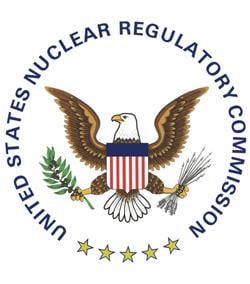The independent agency that governs U.S. nuclear power.

What is it?
The Nuclear Regulatory Commission (NRC) is an independent federal agency* that oversees reactor safety and security, reactor licensing and renewal, radioactive material safety, and spent fuel management (storage, security, recycling, and disposal).
The NRC originated from the Atomic Energy Commission (AEC), which was formed after World War II to promote and regulate peacetime applications of nuclear technology. This dual mission was criticized as a source of inherent conflicts of interest, so the Energy Reorganization Act of in 1974 replaced the AEC with two agencies, the NRC and the Energy Research and Development Administration (ERDA), with NRC inheriting AEC's regulatory functions.
In Congress, the Senate Environment and Public Works Committee and the House Energy and Commerce Committee have principal responsibility for oversight of domestic nuclear power and the NRC’s activities and budget. Congress requires the NRC to provide semi-annual reports on its operations and regulatory activities and has passed other legislation that mandates certain actions of the NRC and guides its mission.
How is it constituted?
The NRC is made up of five commissioners, one of whom is the chairman, appointed by the President and confirmed by the Senate. They are appointed for staggered five-year terms. No more than three can come from the same political party.
In addition to the commissioners, the agency has nearly 4,000 other employees in the accounting, budget, administrative, legal, engineering, information technology, investigative, scientific, and security fields.
How does it work?
The Commission formulates policies and regulations governing nuclear reactor and materials safety, issues orders to licensees, and decides legal matters brought before it. It issues licenses, provides oversight, enforces regulations, evaluates operations, provides support, and responds to incidents. It also performs inspections of nuclear power plants, both routine and in response to problems.
In fiscal year 2012, the NRC’s budget was just over $1 billion. Statutorily, 90 percent is recovered directly from the fees paid by licensees.
Its mission is to “license and regulate the nation’s civilian use of byproduct, source and special nuclear materials to ensure adequate protection of public health and safety, promote the common defense and security, and protect the environment.”
Regional offices
The NRC breaks the country into four regions: Region I (Northeast), Region II (Southeast), Region III (Midwest), and Region IV (South Central and West). Each region has an office.
Each reactor has resident inspectors that monitor daily operations. Special inspection teams conduct inspections when problems occur that raise the likelihood of core damage by a factor of 10 or more.
How the NRC regulates
The NRC regulates nuclear power in myriad ways, including the development of rules and orders that impose requirements licensees must meet in order to obtain or retain a license or certificate to use nuclear materials or operate a nuclear facility. These requirements apply to the transportation and use of materials at nuclear facilities and the use of nuclear materials for medical, industrial, and academic purposes.
The NRC also regularly issues guidance documents and engages in other communications with operators, such as confirmatory action letters (CAL’s)–often requiring them to take specific actions or provide information concerning one or more safety issues.
To enforce rules, the NRC may take one or more of several possible actions, including a notice of violation, a fine, or an order requiring immediate compliance (for instance, to suspend a plant's license or to compel it to cease and desist from certain activities).
The NRC’s rule-making process may be initiated by either a member of the NRC’s technical staff or a member of the public who wishes a rule to be created, revised, or rescinded. The public and other local and state officials can influence NRC decision making through these various regulatory processes as well as other avenues, such as public hearings and communication with regional administrators or resident inspectors.
*An independent federal agency, while part of the executive branch, is not part of the president’s cabinet, which means that the president has less authority to dismiss a member of the agency’s governing board—in this case, the five NRC commissioners.




